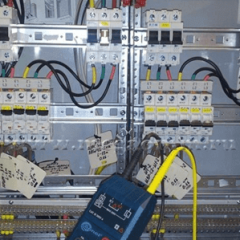How and by whom is the lightning protection test of buildings and structures carried out
Who is checking
A check of the lightning protection system is needed in order to make sure that all its component parts comply with all the requirements of regulatory documents and rules, such as:
- Instructions for the installation of lightning protection of buildings and structures (RD 34.21.122-87, СО 153-34.21.122-2003);
- PTEEP;
- PUE.
But before telling how the system is checked, you need to figure out who inspects the lightning protection of buildings and structures. You do not have the right to conduct it yourself. Such services can be provided by certified organizations, for example, electric laboratories or other organizations that provide such services and are certified by ROSTEKHNADZOR.
At enterprises, the chief power engineer or another person appointed by the boss is responsible for the timely implementation or fulfillment of the requirements of third-party organizations. Organizations such as the Ministry of Emergencies can request verification.
Methodology
Before proceeding to the measurements, specialists study the project documentation and the characteristics and parameters indicated in it. The next step is a visual inspection of the state of the system. At the same stage, mechanical joints are checked by tapping the welds, they are also inspected for corrosion. After checking the external state, go to ground loop resistance measurement.
Interesting! Large objects, such as warehouses, workshop premises or open switchgears, can have several lightning rods. Then the procedure is carried out for each of them separately.
So, to summarize, the lightning protection test of buildings and structures includes:
- External inspection of devices and structural elements.
- Troubleshooting.
- Inspection and search for corrosion on the elements of the system.
- Checking the serviceability and reliability of electrical contacts.
- Earth loop resistance measurement.
The resistance value of the ground loop of lightning rods should not exceed more than 5 times the values obtained when the facility was commissioned. If they exceed, they conduct an audit of the ground electrode system.
Documentation
After checking the lightning protection of buildings, the owner receives a technical report with the real characteristics of the system and the act of verification. Additionally, a protocol is attached to it, which describes the course of measurements and measures, as well as documents from the electrical laboratory that carried them out.
Necessary appliances
Measurement of grounding resistance is carried out by specialized devices, these include:
- Ф4103-М1;
- M416;
- MRU-101;
- IS-20/1.
Usually they measure the grounding of lightning protection of buildings and structures according to a three-pole scheme. You can see it on the example of the MRU-101 device below:
A four-pole measurement circuit is also used:
Important! Measuring instruments must pass state verification.
Categories of premises and terms of verification
Inspection of lightning protection of buildings and structures can be both planned and extraordinary. The reason for an extraordinary inspection of measurements may be:
- Changes in the design of the lightning protection system.
- Repair or reconstruction carried out according to the requirements of previous inspections.
- When repairing or restoring an object after accidents and the like.
Scheduled inspections are carried out in accordance with PTEEP and RD 34.21.122-87, depending on the category of objects:
Category I - premises and buildings of factories, production, in which gases, vapors or dust of fibers can accumulate during operation, which, as a result of a lightning strike, can explode or catch fire. Thus, not only the facility and its personnel, but also nearby institutions can suffer.
Category II - it includes industrial facilities where an accumulation of explosive substances may occur as a result of disruption of the working cycle (production technology). In addition to premises, this category includes installations located outside buildings - on the street, which contain explosive substances in a liquid or gaseous state.
Category III - all other objects are attributed to it, as a result of the destruction of which there will be less material damage. These are buildings with structures made of materials with low fire resistance, as well as those in which there are rooms with increased fire hazard. Other household buildings are also included here, as a result of which electrical effects on people can occur. An example is the chimneys of a boiler house, towers, chimneys of a private house.
It is also important to pay attention to when the lightning protection test is carried out. According to p.1.14 RD 34.21.122-87 lightning protection of buildings and structures is checked at the following times:
- for buildings and structures of I, II categories, it is carried out once a year before the start of the thunderstorm season;
- for category III, lightning protection of buildings is checked at least 1 time in 3 years.
At the same time, we note that in accordance with PTEEP, once every 12 years, the grounding device is checked with a partial opening of the soil, and the resistance of the electrical installation loop with a voltage of up to 1 kV is checked at least 1 time in 6 years.
Important! Measurements should be taken during drought or freezing of the soil when its resistance is highest.
That is all we wanted to tell regarding this issue. If you have questions, be sure to ask them in the comments under the article!
Related materials:











